Welcome to the latest selection of recent top articles in the physica status solidi journals. Get a glimpse of our publication spectrum and visit our pages by clicking on any of the DOI links below.
RRAMs based on anionic and cationic switching: a short overview [Review@RRL]
S. Clima, K. Sankaran, Y. Y. Chen, A. Fantini, U. Celano, A. Belmonte, L. Zhang, L. Goux, B. Govoreanu, R. Degraeve, D. J. Wouters, M. Jurczak, W. Vandervorst, S. De Gendt, and G. Pourtois
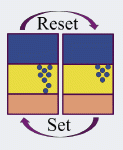 The authors give an overview of the switching kinetics and defect thermodynamics for Cu-based and HfO2-based resistive random access memories (RRAMs). First-principles defect formation energies explain the favorable conditions for conducting defects to form. Atomistic mechanisms that are thought to be at the origin of the device switching are discussed.
The authors give an overview of the switching kinetics and defect thermodynamics for Cu-based and HfO2-based resistive random access memories (RRAMs). First-principles defect formation energies explain the favorable conditions for conducting defects to form. Atomistic mechanisms that are thought to be at the origin of the device switching are discussed.
Phys. Status Solidi RRL (2014) DOI 10.1002/pssr.201409054
Silicone oxidation for a-Si:H passivation of wafers bonded to glass [Rapid Research Letter · rrl solar]
Stefano Nicola Granata, Twan Bearda, Guy Beaucarne, Yaser Abdulraheem, Ivan Gordon, Jef Poortmans, and Robert Mertens
![]() A method to passivate the surface of a wafer/silicone/glass stack to state-of-the-art values (SRV < 4 cm/s) is presented. The method is based on an O2-plasma and an HF/TMAH/HF cleaning sequence that increase the silicone cross-linking and its resilience to process-induced degradation. The method is proven to work for three different silicone-based photovoltaic encapsulants and is believed to significantly broaden the adhesive choice for module-level processing of wafer-based silicon solar cells.
A method to passivate the surface of a wafer/silicone/glass stack to state-of-the-art values (SRV < 4 cm/s) is presented. The method is based on an O2-plasma and an HF/TMAH/HF cleaning sequence that increase the silicone cross-linking and its resilience to process-induced degradation. The method is proven to work for three different silicone-based photovoltaic encapsulants and is believed to significantly broaden the adhesive choice for module-level processing of wafer-based silicon solar cells.
Phys. Status Solidi RRL (2014) DOI 10.1002/pssr.201409081
Microwave permittivity and permeability of magnetic wire composites [Feature Article]
Larissa Panina and Dmitriy Makhnovskiy
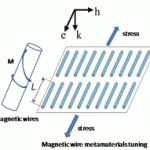 The authors provide a comprehensive review on electromagnetic properties of composites with magnetic microwires. The analysis is made in terms of the effective parameters: permittivity and permeability. The use of magnetic components in wire media makes it possible to realise controllable or tunable electromagnetic materials operating at GHz frequencies. The figure shows a resonant magnetic wire system the effective permittivity of which is controlled by applied tensile stress which rotates the magnetisation towards circular direction decreasing the high frequency impedance.
The authors provide a comprehensive review on electromagnetic properties of composites with magnetic microwires. The analysis is made in terms of the effective parameters: permittivity and permeability. The use of magnetic components in wire media makes it possible to realise controllable or tunable electromagnetic materials operating at GHz frequencies. The figure shows a resonant magnetic wire system the effective permittivity of which is controlled by applied tensile stress which rotates the magnetisation towards circular direction decreasing the high frequency impedance.
Phys. Status Solidi A (2014) DOI 10.1002/pssa.201300767
Influence of electrodes’ distance upon properties of intrinsic and doped amorphous silicon films for heterojunction solar cells [Original Paper]
N. Brinkmann, A. Gorgulla, A. Bauer, D. Skorka, G. Micard, G. Hahn, and B. Terheiden
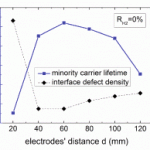 The silicon heterojunction solar cell concept, utilizing stacked films composed of an intrinsic amorphous silicon (a-Si:H) passivation and a doped a-Si:H emitter layer, has attracted much attention. For the doped a-Si:H layer, an optimal doping concentration in this layer, in respect of solar cell efficiency has been found being a compromise between the risen defect density and a higher doping concentration. Brinkmann et al. examine the influence of electrodes’ distance upon the electrical, optical, and structural properties of PECV-deposited thin a-Si:H films with the overall aim to make such layers employable for silicon heterojunction solar cells. Regarding the passivation quality of the a-Si:H film, an optimum electrodes’ distance of 60 mm is found.
The silicon heterojunction solar cell concept, utilizing stacked films composed of an intrinsic amorphous silicon (a-Si:H) passivation and a doped a-Si:H emitter layer, has attracted much attention. For the doped a-Si:H layer, an optimal doping concentration in this layer, in respect of solar cell efficiency has been found being a compromise between the risen defect density and a higher doping concentration. Brinkmann et al. examine the influence of electrodes’ distance upon the electrical, optical, and structural properties of PECV-deposited thin a-Si:H films with the overall aim to make such layers employable for silicon heterojunction solar cells. Regarding the passivation quality of the a-Si:H film, an optimum electrodes’ distance of 60 mm is found.
Phys. Status Solidi A (2014) DOI 10.1002/pssa.201330343
All-electrical detection of spin Hall effect in semiconductors [Feature Article]
Markus Ehlert, Cheng Song, Mariusz Ciorga, Thomas Hupfauer, Junichi Shiogai, Martin Utz, Dieter Schuh, Dominique Bougeard, and Dieter Weiss
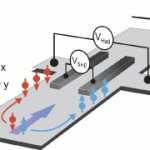 The spin Hall effect (SHE) describes the generation of a spin current perpendicular to a spin-unpolarized charge current in the presence of spin–orbit coupling. In a simple picture the SHE is mediated through spin dependent scattering of charge carriers on impurities, leading to a spatial separation of spin-up and spin-down charge carriers, what finally gives rise to a spin current. By means of the inverse spin Hall effect, that is the reciprocal mechanism of the spin Hall effect, a spin current induces a perpendicular charge current. The SHE offers plenty of potential applications in the large field of semiconductor spintronics, since it can be used as a spin source or as a spin detector. In this Feature Article, Ehlert et al. present different concepts and experiments for the detection of the SHE in semiconductors. In contrast to previous approaches, the focus here is on the all-electrical implementation of such devices, which overcome the necessity of external equipment, e.g. lasers for spin pumping.
The spin Hall effect (SHE) describes the generation of a spin current perpendicular to a spin-unpolarized charge current in the presence of spin–orbit coupling. In a simple picture the SHE is mediated through spin dependent scattering of charge carriers on impurities, leading to a spatial separation of spin-up and spin-down charge carriers, what finally gives rise to a spin current. By means of the inverse spin Hall effect, that is the reciprocal mechanism of the spin Hall effect, a spin current induces a perpendicular charge current. The SHE offers plenty of potential applications in the large field of semiconductor spintronics, since it can be used as a spin source or as a spin detector. In this Feature Article, Ehlert et al. present different concepts and experiments for the detection of the SHE in semiconductors. In contrast to previous approaches, the focus here is on the all-electrical implementation of such devices, which overcome the necessity of external equipment, e.g. lasers for spin pumping.
Phys. Status Solidi B (2014) DOI 10.1002/pssb.201350206
Magnetotransport and magnetization dynamics of GaMnAs thin films and magnetic tunnel junctions [Feature Article]
Aymen Ben Hamida, Sibylle Sievers, Florian Bergmann, Ana-Maria Racu, Mark Bieler, Klaus Pierz, and Hans Werner Schumacher
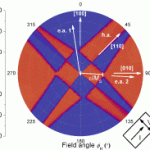 GaMnAs can be considered as the most prominent model system for a diluted ferromagnetic semiconductor. In this article the authors describe the comprehensive characterization of GaMnAs epitaxial thin films and magnetic tunnel junctions by complementary techniques ranging from high-resolution imaging to magnetometry, magnetotransport, time-resolved magneto-optics, and coplanar broadband ferromagnetic resonance. The combination of these different techniques allows a complete characterization of the key magnetostatic and dynamic material parameters of GaMnAs-based thin films and devices.
GaMnAs can be considered as the most prominent model system for a diluted ferromagnetic semiconductor. In this article the authors describe the comprehensive characterization of GaMnAs epitaxial thin films and magnetic tunnel junctions by complementary techniques ranging from high-resolution imaging to magnetometry, magnetotransport, time-resolved magneto-optics, and coplanar broadband ferromagnetic resonance. The combination of these different techniques allows a complete characterization of the key magnetostatic and dynamic material parameters of GaMnAs-based thin films and devices.
Phys. Status Solidi B (2014) DOI 10.1002/pssb.201350210
















